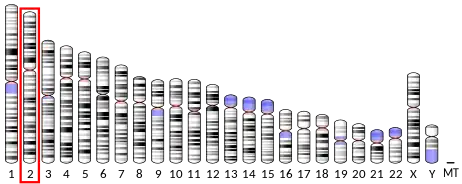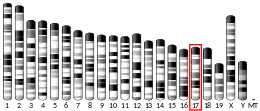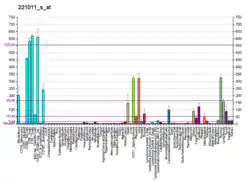The LBH (Limb Bud-Heart) gene is a highly conserved human gene that produces the LBH protein,[5] a transcription co-factor in the Wnt/β-catenin pathway.[6] Upon transcriptional activation of β-catenin, LBH goes on to act as a regulator of cell proliferation and differentiation through multiple transcriptional targets.[7][8] The gene is located on the p arm of chromosome 2 and is roughly 28 kb long.[5] Current ongoing studies are examining its role in developmental and oncological settings.
Gene
Located on chromosome 2, the full sequence is 28495 base pairs long. It contains three exons that will be translated to create the final protein product. Currently, there is no identified promoter region. LBH has a high degree of similarity among many vertebrate species.[5] This is most likely evident of its importance in development and stem cell regulation. Interestingly, LBH has no known paralogs, despite its multifunctionality and expression in different tissues at various stages of development.[5]
Protein
The LBH or Limb-Bud and Heart protein is 105 aa long nuclear protein and is highly conserved across vertebrate species.[5] LBH is a disordered, acidic protein. It lacks any globular fold or secondary and tertiary structures, placing it in the class of intrinsically disordered proteins (IDPs).[9] Research is ongoing on how LBHs conformational flexibility affects its role as a transcriptional regulator. IDPs are known to undergo disorder to order transitions in the presence of certain binding partners.[10] Due to LBHs disordered structure, it may experience multi-functionality through the binding to different targets, producing different transcriptional effects.
Mechanism
LBH or Limb-Bud-Heart was first identified in a 2001 study on transcriptional cofactors for limb patterning in mice. LBH was noted for its expression in developing limb buds and heart formation, hence its name. LBH was hypothesized to act as a transcriptional cofactor due to preliminary examinations of its protein structure and composition.[7] LBH was then found to be directly downstream of the canonical Wnt/β-catenin pathway by downregulating the expression of Wnt, preventing signal completion.[7] The Wnt/β-catenin pathway is a highly conserved pathway that is expressed in a variety of tissues and stages.[11] Direct overlap of in vivo expression of Wnt/β-catenin pathway activation and LBH expression during limb bud development gives evidence for a direct interaction between Wnt/β-catenin and LBH.[7]
Recent studies have found that LBH has a significant role in the regulation of stem cell growth and proliferation in mammary glands. LBH induces expression of ΔNp63, a key epithelial stem cell transcription factor, to promote basal MaSC differentiation and proliferation growing the basal mammary gland. This is compared to luminal expansion and differentiation, increasing the movement and differentiation of the basal MaSC cells to the luminal surface. Knockdowns in mice have resulted in reduced mammary gland growth during puberty and pregnancy.[8] Inversely, overexpression has been noted in basal subtype breast cancers, furthering LBHs effect on stem cell regulation.[7]
Diseases
The overexpression of LBH is one of the causal factors for birth defects seen in partial trisomy 2p syndrome, an autosomal disorder that causes multiple congenital defects. Partial trisomy 2p patients have a triplication of the p arm of chromosome 2.[12] Transgenic overexpression in mice of the LBH ortholog, Lbh, causes the continued overexpression and downregulation of multiple targets downstream of Lbh, mimicking symptoms of congenital heart disease (CHD) and skeletal defects seen in partial trisomy 2p patients. In addition to this, Lbh overexpression leads to the repression of Nkx2.5 and Tbx5, important regulators in cardiogenesis in developing embryos.[13] The importance of LBH in cardiogenesis is evident of LBHs multifunctionality despite being highly conserved and having no paralogs.
LBH also has an important oncological role in the development of mammary gland tumors. LBH has been noted for its overexpression in aggressive “basal” subtype breast cancers. Studies examining the role of Lbh in tumorigenesis in MMTV-Wnt1 transgenic mice as a model for Wnt induced breast cancer development. Lbh was conditionally deactivated in these transgenic mice, significantly delaying tumor onset and resulted in decreased differentiation and proliferation while also increasing apoptosis.[14]
References
- 1 2 3 GRCh38: Ensembl release 89: ENSG00000213626 - Ensembl, May 2017
- 1 2 3 GRCm38: Ensembl release 89: ENSMUSG00000024063 - Ensembl, May 2017
- ↑ "Human PubMed Reference:". National Center for Biotechnology Information, U.S. National Library of Medicine.
- ↑ "Mouse PubMed Reference:". National Center for Biotechnology Information, U.S. National Library of Medicine.
- 1 2 3 4 5 "Genome Data Viewer - NCBI". www.ncbi.nlm.nih.gov. Retrieved 2022-05-04.
- ↑ Briegel, Karoline J.; Joyner, Alexandra L. (2001-05-15). "Identification and Characterization of Lbh, a Novel Conserved Nuclear Protein Expressed during Early Limb and Heart Development". Developmental Biology. 233 (2): 291–304. doi:10.1006/dbio.2001.0225. ISSN 0012-1606. PMID 11336496.
- 1 2 3 4 5 Rieger, Megan E.; Sims, Andrew H.; Coats, Ebony R.; Clarke, Robert B.; Briegel, Karoline J. (September 2010). "The Embryonic Transcription Cofactor LBH Is a Direct Target of the Wnt Signaling Pathway in Epithelial Development and in Aggressive Basal Subtype Breast Cancers". Molecular and Cellular Biology. 30 (17): 4267–4279. doi:10.1128/MCB.01418-09. ISSN 0270-7306. PMC 2937547. PMID 20606007.
- 1 2 Lindley, Linsey E.; Curtis, Kevin M.; Sanchez-Mejias, Avencia; Rieger, Megan E.; Robbins, David J.; Briegel, Karoline J. (2015-03-01). "The WNT-controlled transcriptional regulator LBH is required for mammary stem cell expansion and maintenance of the basal lineage". Development. 142 (5): 893–904. doi:10.1242/dev.110403. ISSN 0950-1991. PMC 4352974. PMID 25655704.
- ↑ Al-Ali, Hassan; Rieger, Megan E.; Seldeen, Kenneth L.; Harris, Thomas K.; Farooq, Amjad; Briegel, Karoline J. (2010-01-01). "Biophysical characterization reveals structural disorder in the developmental transcriptional regulator LBH". Biochemical and Biophysical Research Communications. 391 (1): 1104–1109. doi:10.1016/j.bbrc.2009.12.032. ISSN 0006-291X. PMC 2827303. PMID 20005203.
- ↑ Camacho-Zarco, Aldo R.; Schnapka, Vincent; Guseva, Serafima; Abyzov, Anton; Adamski, Wiktor; Milles, Sigrid; Jensen, Malene Ringkjøbing; Zidek, Lukas; Salvi, Nicola; Blackledge, Martin (2022-04-21). "NMR Provides Unique Insight into the Functional Dynamics and Interactions of Intrinsically Disordered Proteins". Chemical Reviews. 122 (10): 9331–9356. doi:10.1021/acs.chemrev.1c01023. ISSN 1520-6890. PMC 9136928. PMID 35446534.
- ↑ Rao, Tata Purushothama; Kühl, Michael (2010-06-25). "An updated overview on Wnt signaling pathways: a prelude for more". Circulation Research. 106 (12): 1798–1806. doi:10.1161/CIRCRESAHA.110.219840. ISSN 1524-4571. PMID 20576942. S2CID 20442737.
- ↑ Francke, Uta (1976-11-01). "The 2p Partial Trisomy Syndrome: Duplication of Region 2p23 → 2pter in Two Members of a t(2;7) Translocation Kindred". American Journal of Diseases of Children. 130 (11): 1244–1249. doi:10.1001/archpedi.1976.02120120078014. ISSN 0002-922X. PMID 984008.
- ↑ Briegel, Karoline J.; Baldwin, H. Scott; Epstein, Jonathan A.; Joyner, Alexandra L. (2005-07-15). "Congenital heart disease reminiscent of partial trisomy 2p syndrome in mice transgenic for the transcription factor Lbh". Development. 132 (14): 3305–3316. doi:10.1242/dev.01887. ISSN 1477-9129. PMID 15958514. S2CID 2288498.
- ↑ Ashad-Bishop, Kilan; Garikapati, Koteswararao; Lindley, Linsey E.; Jorda, Merce; Briegel, Karoline J. (January 2019). "Loss of Limb-Bud-and-Heart (LBH) attenuates mammary hyperplasia and tumor development in MMTV-Wnt1 transgenic mice". Biochemical and Biophysical Research Communications. 508 (2): 536–542. doi:10.1016/j.bbrc.2018.11.155. PMC 6368957. PMID 30509497.
Further reading
- Maruyama K, Sugano S (1994). "Oligo-capping: a simple method to replace the cap structure of eukaryotic mRNAs with oligoribonucleotides". Gene. 138 (1–2): 171–4. doi:10.1016/0378-1119(94)90802-8. PMID 8125298.
- Bonaldo MF, Lennon G, Soares MB (1997). "Normalization and subtraction: two approaches to facilitate gene discovery". Genome Res. 6 (9): 791–806. doi:10.1101/gr.6.9.791. PMID 8889548.
- Suzuki Y, Yoshitomo-Nakagawa K, Maruyama K, et al. (1997). "Construction and characterization of a full length-enriched and a 5'-end-enriched cDNA library". Gene. 200 (1–2): 149–56. doi:10.1016/S0378-1119(97)00411-3. PMID 9373149.
- Hartley JL, Temple GF, Brasch MA (2001). "DNA cloning using in vitro site-specific recombination". Genome Res. 10 (11): 1788–95. doi:10.1101/gr.143000. PMC 310948. PMID 11076863.
- Venter JC, Adams MD, Myers EW, et al. (2001). "The sequence of the human genome". Science. 291 (5507): 1304–51. Bibcode:2001Sci...291.1304V. doi:10.1126/science.1058040. PMID 11181995.
- Strausberg RL, Feingold EA, Grouse LH, et al. (2003). "Generation and initial analysis of more than 15,000 full-length human and mouse cDNA sequences". Proc. Natl. Acad. Sci. U.S.A. 99 (26): 16899–903. Bibcode:2002PNAS...9916899M. doi:10.1073/pnas.242603899. PMC 139241. PMID 12477932.
- Ota T, Suzuki Y, Nishikawa T, et al. (2004). "Complete sequencing and characterization of 21,243 full-length human cDNAs". Nat. Genet. 36 (1): 40–5. doi:10.1038/ng1285. PMID 14702039.
- Wiemann S, Arlt D, Huber W, et al. (2004). "From ORFeome to biology: a functional genomics pipeline". Genome Res. 14 (10B): 2136–44. doi:10.1101/gr.2576704. PMC 528930. PMID 15489336.
- Briegel KJ, Baldwin HS, Epstein JA, Joyner AL (2005). "Congenital heart disease reminiscent of partial trisomy 2p syndrome in mice transgenic for the transcription factor Lbh". Development. 132 (14): 3305–16. doi:10.1242/dev.01887. PMID 15958514.
- Tao WA, Wollscheid B, O'Brien R, et al. (2005). "Quantitative phosphoproteome analysis using a dendrimer conjugation chemistry and tandem mass spectrometry". Nat. Methods. 2 (8): 591–8. doi:10.1038/nmeth776. PMID 16094384. S2CID 20475874.
- Mehrle A, Rosenfelder H, Schupp I, et al. (2006). "The LIFEdb database in 2006". Nucleic Acids Res. 34 (Database issue): D415–8. doi:10.1093/nar/gkj139. PMC 1347501. PMID 16381901.




